Introduction
Within This Page
Traditionally, buildings have been created to meet certain needs—function, comfort, and budget—but minimally focused on how well they fit with the natural environment. They also have been designed and constructed for uses and conditions of the moment, and therefore usually require remodeling or replacement when needs or circumstances change, a costly approach both financially and environmentally. Buildings tend to be thought of as static edifices that remain the same over decades, interacting little with their environment or occupants. Sustainable design has begun to change these conceptions through the establishment of green building standards and rating systems intended to create buildings that respond to the environment. Yet, several interrelated, innovative building concepts are now challenging the traditional building paradigm and even today's standards for sustainable design by introducing the idea of buildings as more dynamic and interactive structures. These include the concepts of living, regenerative, restorative, and adaptive buildings. These buildings differ in their innovative strategies and technologies that seek to integrate and restore the natural environment rather than just addressing the building design itself. These strategies aim to move more quickly than traditional design strategies to achieve truly sustainable outcomes.
Currently, these strategies and their design processes are in the next stages of development. The building industry is starting to apply these strategies more rapidly and the federal government has the opportunity to lead by example through the application of these new ideas in current and future projects. This page will provide an overview of the living, regenerative, and restorative concepts as well as those of adaptive buildings.
Description
The concepts of living, regenerative, restorative, and adaptive buildings are outlined and differentiated in the sections below.
Living Buildings
Living buildings either are autonomous and not reliant upon the electrical grid or other utility systems to operate, or, in accordance with the concept of net-zero, they take in resources (from the electrical grid, public water supply, etc.) at levels equal to or less than what they return to the community and the environment (in renewable energy, recyclables, etc.). Most of these buildings still need to be connected to the grid in order to contribute excess energy from on-site power generation back to the community. In weather, power, or security-related emergencies, these buildings can provide their own power from on-site sources, reducing the need to be reliant upon the grid. Living buildings are also designed, operated, and managed to have no negative health impacts upon occupants.
A Living Building is integrated with and mimics natural processes, and obtains all necessary resources for operation from the natural environment (rainwater, wind, sunlight), which achieves a net-zero impact on the environment as discussed above. A Living Building produces its own energy from renewable sources and releases zero greenhouse gas emissions; it functions with the water that falls upon the site, capturing rainwater for interior and exterior uses; and treats all wastewater on-site. It creates zero net waste and sources sustainable materials. By doing so, the building can function autonomously from power grids and municipal water systems. The Living Building Challenge (LBC) is the first sustainable building certification system that provides design and construction teams with guidelines for how to integrate living building concepts. The guidelines and examples are further outlined below.
Regenerative and Restorative Buildings
Regenerative and restorative buildings go beyond living building levels by also improving the surrounding environment such as restoring a site's natural hydrology or providing for lost wildlife and plant habitat. These buildings are integrated into the natural environment and designed to improve damaged surrounding environments.
Regenerative and restorative buildings not only produce all of their own energy, capture and treat all water, but they are also designed and operated to have a net-positive impact on the environment, including repairing surrounding ecosystems. Producing more energy than the building consumes and sharing the excess so other buildings can meet their energy demands; creating opportunities for urban agriculture such as growing food on a green roof; recharging groundwater systems or creating ecosystems for local species whose niches had been missing, damaged, or destroyed, are examples of how a building can help restore the environment. In order to share excess energy with surrounding buildings produced from on-site power generation, the building would need to be connected to the grid.
The fine distinction is that restorative design is reversing damage that has been caused to a particular site by either nature or humans, while regenerative design is creating even better conditions to support the life-enhancing qualities of ecosystems.
A regenerative building and the regenerative design process not only restores but also improves the surrounding natural environment by enhancing the quality of life for biotic (living) and abiotic (chemical) components of the environment. The regenerative design process promotes the pattern of relationships between the physical, built, and natural environment. The laws of heat transfer, thermodynamics, and material performance in a harsher climate determine overall system design and equipment selection versus a milder climate. In the regenerative design process, the same principles are followed as for living and restorative buildings, but include all aspects of systems thinking from site, water, materials, and energy to plants, microbes, human social systems, and culture.
All of these design processes require a different way of engaging the design team than simply recommending green technologies. The end result is buildings that not only sustain all of their needs on-site, but also contribute to the health of the environment around them, increase biodiversity, and sustain a living relationship with the environment around them.
Note: Both living and regenerative buildings result in no net pollutant emissions to the environment (water, air, or land) and no net health impacts to occupants. They are also flexible enough in design and operation to adapt as needs and conditions change.
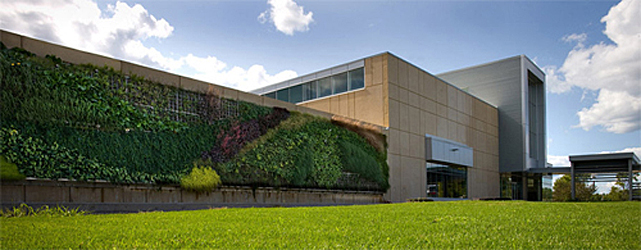
The Centre for the Built Environment (CBE) located on the Waterfront Campus of Nova Scotia Community College, is an example of restorative building design, blending elements of the 'natural' environment with the 'built' environment to ensure the building and its operations do not contribute to environmental harm.
Adaptive Buildings
The concepts and technologies to support adaptive building systems are both available and dependable. Adaptive façades are poised to capitalize on technology transfer from other disciplines, which can allow the building industry to mass produce sustainable building parts and bring down the cost of these systems to attractive levels. Open buildings are also a method for creating an adaptable building in that they are easily remodeled and can easily be adapted for new purposes for which they were not originally conceived.
Climate Adaptation
Strategic decisions on location and layout of a building can significantly reduce risks associated with climate change such as higher temperatures and water resource shortages. Designing buildings for climate change contributes to zero impact due to the building's ability to adapt to changes in climate without having to redesign, and in some cases rebuild. Such strategies may include flood resistant materials and drainage planning, drought resistant landscaping, passive cooling, planting for shade, enhanced foundations, and careful planning of vegetation, ensuring buildings do not obstruct biodiversity corridors, and material selection based on heat island effect. Buildings must also be designed to withstand other natural hazards including high winds to reduce damage to the building envelope, protect occupants, and minimize heat gain, heat loss, and moisture penetration. Distributed energy resources, small-scale power generation sources located close to where the energy is used, can provide an alternative to the traditional electric power grid and offer the potential for lower cost, higher service reliability, high power quality, increased energy efficiency, and energy independence.
Adaptable Technologies
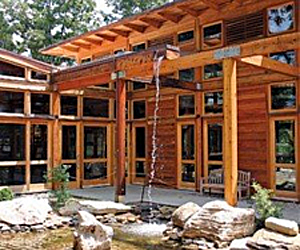
This Arboretum and Research Visitor's Center designed for adaptability, optimizes material use over the life cycle of the building by integrating flexibility and disassembly into the design.
Photo Credit: Lifecycle Building Challenge Awards
There are also specific technologies that help in adapting to the environment such as phase change materials that are capable of storing and releasing large amounts of energy by changing from solid to liquid. One example is electrochromic windows which allow control of how much light and heat moves through them by voltage applied to the window causing them to lighten or darken. This offers an opportunity for the windows to be used as energy saving devices. Similarly, there are window shades and lights that brighten in response to the amount of daylight available.
Integrative Design / Systems Thinking
The Living Building Challenge (LBC), administered by the International Living Future Institute, is a certification program as well as a philosophy or framework defining many of the issues of interest for living, restorative, and regenerative buildings. The following discussion draws from the imperatives of the Living Building Challenge.
Site
Buildings must have an intelligently chosen project site. Strategies include limiting development growth by using only sites that have been previously built upon, supporting living processes such as on-site agriculture and urban agriculture, using ethical construction practices, and protecting soil through management plans. Brownfields, greyfields, and previously developed sites are all examples of sites for a living, restorative, or regenerative building.
Beginning with smart site selection, negative impacts a building may have on the environment can be eliminated, and in some cases, the building can help to return resources back to the environment through on-site water treatment, on-site recycling of resources, agriculture, and habitat exchange. Considering proximity to alternative transportation during site selection further decreases the impact of the building and adds value by increasing community connectivity. Site selection is the first decision that will greatly influence all subsequent building and system design choices. On-site power generation from solar and/or wind, for example, is dependent on the orientation of the building. This applies to passive solar heating, daylighting and natural ventilation. Living, regenerative, and restorative buildings must find the optimal balance between environmental impacts and sustainable building design.
Materials and Waste
Appropriately-sourced materials supporting regional economies and limiting transportation impacts must be considered for all projects. For example, renewable technologies should come from no further than 15,000 km away while heavy or high-density materials should come from no further than 500 km away. Using higher quality sustainable materials also contributes to the durability of the building.
All timber products must be salvaged, felled on-site for construction, or certified by the Forest Stewardship Council (FSC). FSC certification verifies that the timber product or non-timber forest product was sourced from responsibly-managed forests.
The reduction or elimination of waste is another aspect of the construction and operation of buildings. For example, the LBC requires 80–100% of construction waste, depending on what type of material it is, to be recycled and diverted from landfills. A "Materials Red List" identifies materials and chemicals with health and toxicity concerns that cannot be in products or materials contained within the project.
To complete the Cradle to Cradle (C2C) cycle of the materials, waste, and the building itself, a plan for adaptable reuse and deconstruction ensures all materials will be reused on- or off-site and all waste recycled.
Water
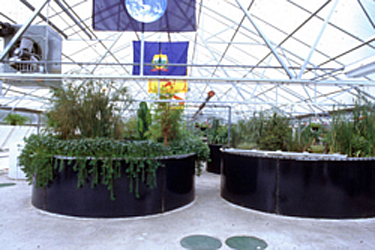
These Eco-Machines are wastewater filtration systems that utilize multiple filtration processes from anaerobic to mechanical.
To achieve the goal of net zero water use, buildings must reduce their reliance on municipal water systems and capture 100% of their water from the rain through rainwater harvesting systems, cisterns, and closed loop water systems. Water capture and reuse reduces runoff rates and reduces stress on municipal water reservoirs and infrastructure. A living, restorative or regenerative building not only satisfies its water needs from rainwater, but also improves water quality through filtration, and reversing effects of erosion through low impact development strategies such as bioswales and replanting native vegetation.
A green roof can capture and filter rainwater on-site and also provides a vegetated habitat while also reducing cooling needs in some climates.
To achieve net zero water use on-site, specify compostable toilets and waterless urinals, or minimize the use of water through water-efficient fixtures, including high efficiency toilets and urinals and low-flow faucets.
Energy
Living, restorative, and regenerative buildings are net zero energy. One hundred percent of the building's energy demand must be obtained through on-site renewable energy. Renewable energy sources include building-integrated photovoltaics, wind turbines, or fuel cells powered by hydrogen generation (as long as no combustion is involved).
An important first step toward a net zero energy building is to minimize the energy loads required. This can be accomplished through energy efficient HVAC design, passive solar design, increased insulation, high-efficiency building envelope, natural ventilation, high performance glazing, high-performance appliances, and meticulous weatherproofing.
Maintaining net zero energy can be achieved through rigorous preventative maintenance of all systems, detailed operations and management plans, and an educated maintenance staff. Continued benchmarking and monitoring of building operations, maintenance, and performance is an integral piece of preventative maintenance. (See also Building Commissioning).
Human Health and Happiness
An intrinsic part of living, restorative, and regenerative building design is a focus on occupant health and happiness, highlighting the interconnection between nature and occupant comfort and health. A healthy work environment is a more productive environment. Optimizing daylight and access to views are other factors in achieving occupant satisfaction with their work environment.
Equity and Beauty
Project teams must be mindful of the fact that buildings will be occupied by people whose health, happiness, and productivity rely on the design and function of the space.
The Living Building Challenge emphasizes concepts of social justice and democracy, as well as human sustainability, adaptability, and resiliency. All of these elements resonate with a strong sense of place and user emphasis integrating diversity, mutual respect, and aesthetic appeal.
All buildings need elements of beauty within their design. Many buildings from the mid- to late-20th century until the present day were designed to address functional and economic concerns only. By integrating design elements that take into consideration beauty, education, and biophilia, these buildings celebrate culture and recapture the human spirit.
Application
Living, restorative, and adaptive building design concepts are still in their infancy. Only a few buildings have achieved certification through the Living Building Challenge to date. However, these concepts are applicable to most building types as well as to landscapes, infrastructure, or community development.
Project Examples
By achieving Living certification status or Petal recognition within the LBC, these projects demonstrate that buildings can improve the ecosystems they inhabit. Projects that meet the requirements for a single category may achieve individual Petal designation. To achieve Living certification status, all imperatives must be met. LBC certification is based on actual, rather than modeled or anticipated, performance. Therefore, projects must be operational for at least twelve consecutive months prior to being evaluated. The examples provide highlights of each project's journey from inspired vision to completed building. For more information on the projects outlined below, see The Living Building Challenge (LBC).
Omega Center for Sustainable Living
Located in Rhinebeck, New York, the Omega Center provides innovative educational experiences that awaken the best in the human spirit. The Omega Center is an environmental education center and wastewater filtration facility that is designed to use the treated water for garden irrigation and in a greywater recovery system.
- Site: reuse of solid debris landfill and fill removed and resold
- Materials: Embodied carbon footprint = -1,387 metric tons
- Water: annual water use all harvested on-site and all grey and black water treated on-site
- Energy: generate almost 40,000 kWh per year via solar panels which is more than their 37,190 kWh/yr needs
- Health: ducts protected during construction, low-VOC material selection throughout, and a green cleaning program
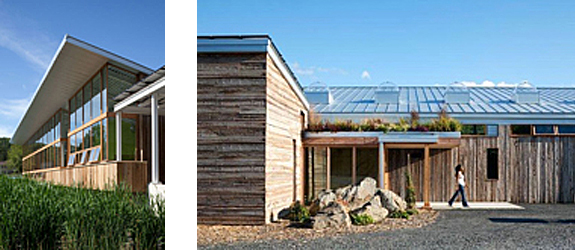
The Omega Center for Sustainable Living is one of three certified living buildings in the world.
Photo Credits: OCSL
The Tyson Living Learning Center
Located at Tyson Research Center, the Tyson Living Learning Center is an environmental field station for Washington University in St. Louis, Missouri. The site was transformed from a degraded asphalt parking lot to a native landscaped garden replete with pervious concrete, local stone pavers, and a central rain garden. The building fosters indoor/outdoor education with a large multi-use classroom that opens directly out to a locally-harvested white oak deck. Net zero energy is achieved by using photovoltaic panels mounted both on the roof and on two horizontal trackers. Potable water is provided by a chemical-free rainwater harvesting system. Greywater is treated in an infiltration garden and blackwater by composting toilets effectively eliminating the concept of waste.
- Site: previously developed parking lot
- Materials: wood salvaged and harvested on-site
- Water: all water captured on-site and black water broken down through a composting system
- Energy: high efficiency HVAC design and all energy needs supplied by solar panels
- Health: low-VOC materials, green cleaning plan and a high daylighting factor
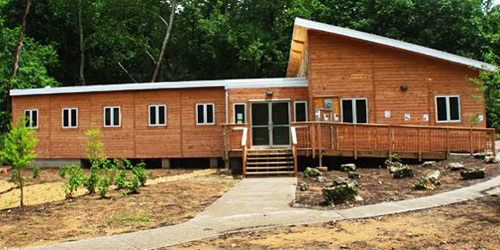
The entrance to the Tyson Living Learning Center at Washington University in St. Louis.
Eco-Sense
Eco-Sense is a private home located in Victoria, British Columbia that functions as a part of the eco-system, blurring the line that separates where the dwelling ends and where nature begins. The residence was the dream of Ann and Gord Baird who wanted to build a sustainable home for their three generation family of six. The family walks the talk of sustainable living with a conservation first philosophy. The house was also the first code-approved, seismically engineered, load-bearing insulated cob (clay, sand, and straw) building in North America.
- Site: brownfield
- Materials: cob, clay, sand, and straw house; extensive reuse of light fixtures, plumbing fixtures, and lumber
- Water: green roof to mitigate storm water, composting toilet, and all water harvested on-site
- Energy: use of solar panels and wood gasification
- Health: low-VOC materials throughout, acoustical design, more natural light, wheelchair accessible, and the clay structure does not allow for mold
Relevant Codes and Standards
While many codes, standards, and regulations serve as a starting point for establishing sustainability goals and targets, it is possible that by incorporating the principles of living, regenerative, restorative, and adaptable buildings, the design community may improve upon these standards and create models that go beyond any of those outlined below.
- ASHRAE Standards
- Executive Orders
- Federal Codes
- Legislation
Additional Resources
Associations / Organizations
- BNIM
- Cascadia Green Building Council
- Forest Stewardship Council (FSC)
- Integrative Design Collaborative
- International Living Future Institute
- Lifecycle Building Challenge
- Living Building Challenge
- The Natural Step Approach
- Sustainable Sites Initiative
Publications
- Code, Regulatory and Systemic Barriers Affecting Living Building Projects by David Eisenberg and Sonja Persram. Cascadia Region Green Building Council, 2009.
- The Integrative Design Guide to Green Building: Redefining the Practice of Sustainability by B. Reed and J. Boecker. Hoboken, NJ: John Wiley & Sons, 2009.
- The Sustainable SITES Initiative Guidelines and Performance Benchmarks 2009 by the American Society of Landscape Architects, Lady Bird Johnson Wildflower Center at The University of Texas at Austin, and United States Botanic Garden. 2009.








